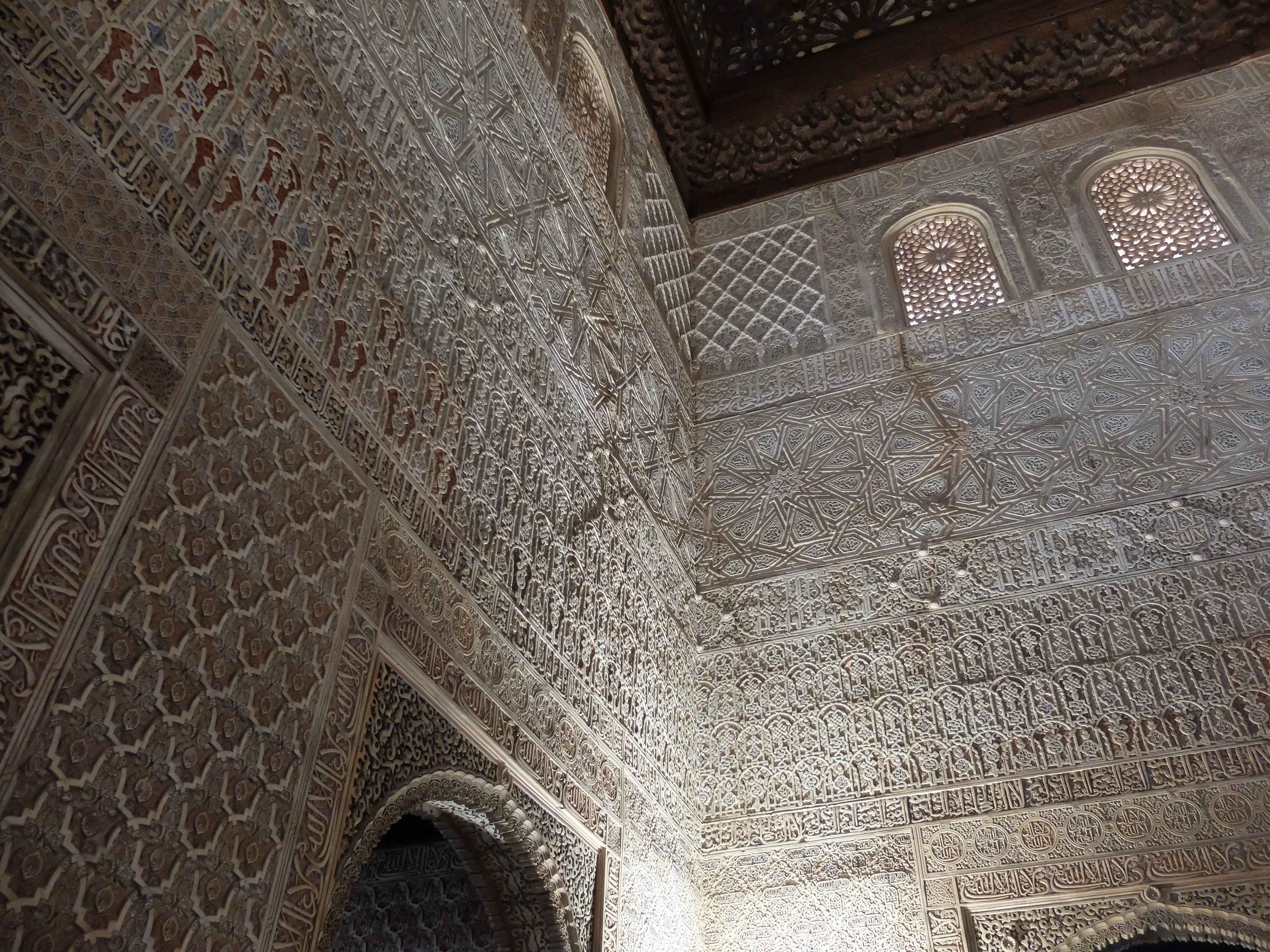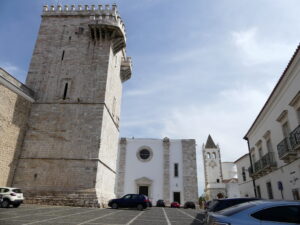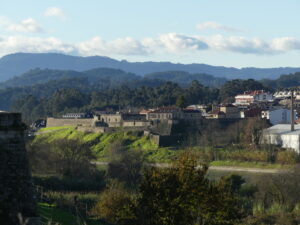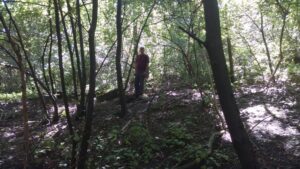
Except for one day during our visit in Spring 2018, Granada was as sodden and chilly as the rest of western Europe. Yet, on this first trip together to the south of Spain, we were still ardent to drive here and tour the famous Alhambra.
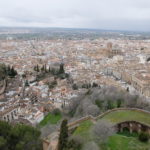
We had chosen to come here from Lisbon for a bit of a holiday after a busy time with lots of preoccupations. With just a few days available, moreover, we decided not to jam into our schedule any of the other storied cities of the south – Malaga, Sevilla, Cordoba – or other unfamiliar ones that friends recommended, like Ronda or Estepona. Those will have to wait for another visit. It did us good to slow down in Granada, see many things unrushed – particularly given the nearly non-stop drizzly, dark, chilly weather.

Though the Alhambra was the main attraction for us, we expected to find other things to see and do, without pressure. So we chose two options atypical for us: first, staying in the heart of the old city and second, buying the tourist card that covers admissions to Alhambra and other places.
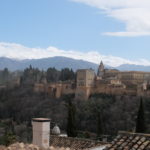
Why not typical? As we prefer apartments for a longer stay, many of these in the center city require putting up with tourist-driven street noise – whether car and pedestrian traffic, bars and pubs sprawling out into the street, or – more frequently than one might expect – construction nearby as renovations open up apartments and hotels for more tourists. Instead, we have enjoyed staying within neighborhoods that better represent the way that the locals live.
As for the tourist card, we’ve found them not such a good deal in general and subtle pressure to do more and more, not less and better. Plus it’s a bit frustrating to find this place of interest to us over here or that other one over there not even covered by the card. Granada’s card (whose details you can find at granadatur.com/granada-card) was priced on the economic margin, but was nearly a must-do because it gave us admission to Alhambra even after regular admission tickets were sold out.
In the end, everything worked out well. Access to the apartment was as tricky as any old town location due to one-way and pedestrian streets. The multi-pane windows of the apartment blocked most of the noise below us on the street, and we had all we needed to be comfortable as well as cook when we wanted. Over the five days, though, we found three superb restaurants for vegetarians like us, some with full meals and some with typical local tapas.
Another plus: our apartment came with a free parking space (instead of those nearby costing 20 Euros per day); we only saw it when we arrived and left.
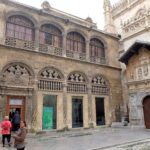
The Granada card drew us to three wondrous sites we might not have seen otherwise – along with that guaranteed admission to Alhambra, plus pre-ticketing for the Cathedral and Royal Chapel. Along the way, we revived our recollections of the history of the city and the Spanish south, pivoting around that critical year 1492.
1492. King Ferdinand and Queen Isabella sent Columbus off to colonize the Indies. The same year marked the Reconquista, when the leader of the Nasrid Muslim monarchy, which had controlled the south of Spain from its base in Granada for nearly 800 years, finally yielded his kingdom to the royal army’s Gran Capitan, de Córdova. The south of Spain then reverted to control by the Spanish kings, whom the Pope dubbed the Reyes Catolicos for their achievement.
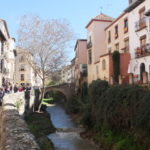
As we walked the charming streets of the central city – on the one sunny day – we saw many reminders of the period before that critical moment in Spanish history, and after.
Of course, we passed that renowned fortified palace of the Nasrids, the Alhambra, both from below on the Carrera del Darro, the Riverwalk of Granada – and from above at the San Nicolas mirador across the Darro valley. We glimpsed other remnants of Nasrid Granada, like the old baths and arched bridges, though much has been supplanted over the years.
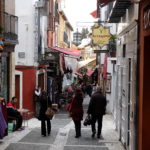
We wandered through the crooked, narrow lanes of Albaicin, the oldest part of town, including the bazaar that is active in goods still, though more for tourists of far-flung lands, rather than trade with those lands. We peered into the courtyard building used by the Nasrids as a horse corral, surprisingly splendid even after all these years.

In the Casa de Zafra, a restored Muslim home included with the Granada card, we peered into rooms surrounding its typical residential central courtyard and pool. There, we learned from a set of displays about the time before – reaching back to the original Iberian tribes, the Roman imperial expansion, the Germanic and Visigothic invaders.
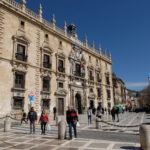
And we passed through the 250 years after 1492, marveling at the grand religious and administrative projects of that period, monumental institutions spurred by the increasing wealth and power that flowed out of the conquest of the Americas and the Reconquista.
Along the river Darro near Granada’s Plaza Nueva, rests the royal chancery, for example – a blend of the baroque and renaissance styles from just 40 years after the Reconquista.
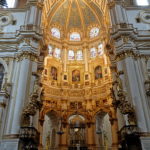
Especially grand is the fourth largest church in the world, the Granada Cathedral whose altarpieces and chapels are heavy in decoration and religious symbolism. And tucked beside it is the charming Royal Chapel, home of the tombs of Ferdinand and Isabella themselves, glorified by the sumptuous artwork around them.
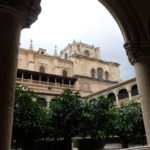
On a more dreary day, we saw two other examples of royal grandeur, monasteries to which we were directed by the Granada card. We might have ventured to one had it not been for the card, but we would not have wanted to miss either of them due to the art in one and the dazzling churches in both.
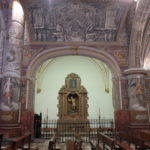
Perversely, these monasteries were intended to hide monks and nuns away from the vanities of the world. They represented, however, a gift of thanks by the royal families for divine support in their conquests, and the wealth that came from these.
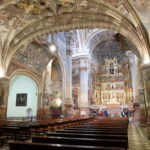
The monastery dedicated to Saint Jerome by Ferdinand and Isabella is an exquisite example of Renaissance Mannerism designed by the renowned architect, Diego de Siloe. The visually elaborate church includes inspired artwork by many Spanish masters of the time. Its altarpiece is not flashy, but it is riveting: from its half arch on top, the rays of the holy spirit spread through a host of painted saints in a highly symbolic four-tiered expression of faith.

The other monastery housed the Carthusian order in elegantly simple rooms that featured religious paintings by Cotan, a masterful artist and monk. Its Rococo church interior is intricately decorated, complementing the flamboyant religious sculptures of its altars.

The Muslim past and the subsequent Spanish centuries haunt Alhambra itself, perched high above Granada. Before 1492, the stony palaces and courtyards within the Alhambra represented a dream of paradise on earth for the Nasrid kings of southern Spain.

Here were their administrative and residential buildings, all heavenly adorned in intricate geometric and calligraphic designs.
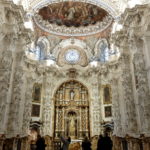
So it’s fitting that up to 6000 people a day, visitors like us who have dreamt of seeing one of the most celebrated sites in Europe, finally have their dream come true at Alhambra, the “red fort.” Our Granada card admission worked smoothly; with no wait, we passed through the Nasrid palace gates at the designated hour.
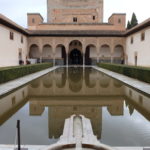
The private rooms of the palaces reflected the pleasures of paradise, especially the central courtyards that connected the rooms for each ruler, spaces like the Court of the Lions and the Court of the Myrtles.
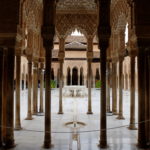
The deceptively simple Lions Courtyard reflected a complex symmetry. At its center is the symbol of Alhambra, the Lion Fountain. The twelve individualized lions all spout water through their mouths, but once constituted a clock which told time by changing which of the lions was spouting.
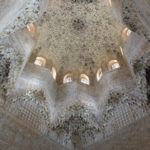
But then there are the exquisite side rooms emanating off the courtyard. Abencerrajes Hall still glows from the subtly inset windows that ensure light shifts during the day through its honeycomb ceiling and stalactite decoration.

Close by, the similarly elegant Two Sisters’ Hall reaches through a lovely arched terrace to the Lindaraja Belvedere, a gallery at its side with a view onto a small garden courtyard below. Another vision of paradise for those within.
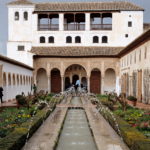
Similarly, across a ravine to the connected hilltop of Generalife, the kings’ summer palace, the gardens and water-spritzing courtyard were intended to delight the eyes and ears of those who stayed there.

Yet the stones of Alhambra also speak of another sort of dreams. The sumptuous public rooms projected power, the dream of endless rule. The Patio of the Golden Room, the entrance to the 14th c. palace of Comares, for example, grandly welcomed visitors.

But the audience hall within the Comares tower remains one of the most magnificent of the Nasrid rooms. Ambassadors might look upward and envision heaven, a starry ceiling formed of thousands of cedar pieces.

On all its walls, intricate carvings invoked divine support for the power of the Nasrid king.
The fortress section, called Alcazaba, also projected that dream of power.
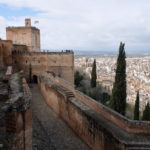
Its red walls and towers stretch to the limits of Alhambra’s hilltop, like the prow of some massive ship of state, dominating the city and keeping watch over the distant countryside – now almost filled by the modern city. Its restored walls and narrow passageways are still solid, but only remnants of its ancient buildings can be seen.
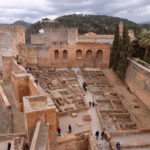
Soon after the 1492 re-conquest, however, Charles V celebrated the victory by transforming part of Alhambra with a neoclassical rectangular palace containing an elliptical courtyard, symbolic of the union of earth and heaven. That new structure would advertise the vast domain of the Holy Roman Empire he controlled.
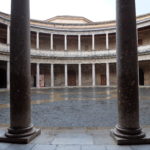
He never occupied his palace. For Alhambra represents nightmares as well: all the empires and their powers failed. The kingdoms crumbled. Much of Alhambra fell into ruins while new structures rose on top of Nasrid Granada.

Then, in the 19th century, tourism increased, partly due to the Nasrid tales re-told by the American writer Washington Irving. Alhambra was restored and revived. Once again, people traveled here to realize their dreams, to see a paradise.
(Also, for more pictures from Spain, CLICK HERE to view the slideshow at the end of the itinerary page.)


